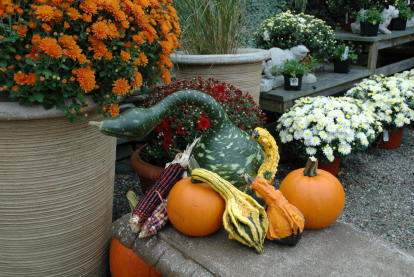Mary Ann Ryan and Denise Dornbush
Adams County Master Gardener

(7/2016) It’s hard to say when my love affair with Sage began. It could have been when I smelled the crushed leaf of a Pineapple Sage. It could have been when I read the old Chinese proverb "How can a man grow old who has Sage in his garden?" Or maybe it was when I saw the hummingbirds flock to my Sage plants.
Sage is a well-known herb. It adorns the pages of cooking magazines, in bottles of vinegar or gracing the turkey platter. What does all this talk about Sage have to do with Salvias? The truth is that all Sages are Salvias. Salvia is the Latin name, or genus, given to all these plants. Over the years the term Sage has been associated with cooking or
medicinal use and the term Salvia has been given to the ornamental members of the genus. So when you hear someone talking about their Salvia officinalis Tricolor, don’t be afraid; they are talking about Tricolor Garden Sage.
The genus Salvia offers one of the largest and most versatile groups of perennials. The Roman scientist Pliny the Elder was the first to use the Latin name Salvia, meaning to heal or save. The common name Sage started in England and referred to Salvia officinalis, a plant used long ago as a household remedy.
Salvias are adaptable to almost any garden condition. Rabbits and deer don’t bother with them and neither do most insects. They are a major source of nectar for hummingbirds and butterflies and goldfinches love the nutritious seeds.
There are 900 recognized species of perennial, biennial and annual sages. All sages have similar flowers in any color you like from white to black and every color in between. What is not to love about these wonderful plants?
Some of my favorites include:
• Hot Lips, a variety released in 2002. It has bicolor flowers of white with red lips. This attractive plant requires full sun and can reach 30 inches tall.
• Salvia coccina "Cherry Blossom" is a new addition to my garden this year. I started these, quite easily, from seed. The flowers are a very pretty light pink, and the catalog promises that they will flower for a long period.
• Salvia nemorosa "Sensation Rose" makes a compact clump of quilted green leaves with branching flower spikes of bright pink. The flowers appear in spring.
• Peruvian Andean Silver Salvia is a tender perennial. This is a beautiful plant with purple-black flowers and lime green calyces (the little cups that hold the flowers.) The leaves are silvery and the stems are cloaked in woolly, white hairs. This plant grows to about 18 inches tall.
• Black and Blue Salvia or Blue anise sage is a tall plant that will reach 2 to 3 feet in height. The bi-colored blooms appear in both the spring and the fall. The calyx is unusual in that it’s black instead of the usual green and the deep blue blooms are a favorite of hummingbirds.
Another plant I started from seed this year is Salvia argentea "Artemis." In the first year this plant makes small rosettes of soft grey woolly foliage. This plant just begs to be touched. Next year the plant will have tall silver spikes with pinkish-white flowers. What an added bonus! I’m happy with it now; it doesn’t need to do anything else next
year.
The list of wonderful sages to grow in the garden continues with:
- Salvia lyrata "Purple Knockout" (Lyre-leaf sage) is grown mainly for its leaves. Burgundy leaves turn deep purple in the summer. Spikes of pale lilac flowers appear in spring and summer. This plant self-sows.
- Russian Sage is graceful and airy, growing 3 to 5 feet tall, topped with lavender flowers. These are very easy to grow. They tolerate poor soil and drought.
- Tricolor Sage has green leaves with white margins with pink or purple. This woody stemmed plant can be trimmed back in the spring. In early summer it sends up lavender-purple spikes. These last a long time in cut arrangements.
- Pineapple Sage is a fun plant to have in the garden. Not only do the leaves smell like fresh pineapple, the plant provides color in the late summer and fall garden. Pineapple sage will wilt and lose leaves during droughts. It is grown as an annual in this area and overwinters well indoors.
- Victoria Sage is a small plant that is big on color. This was one of my first sages and I was happy to find out that it overwinters in this area. Spikes of stunning violet-blue flowers in the summer make this well worth growing. The upright plant is moderately fast-growing and has green lance-shaped leaves which are covered with fine hairs. This
is wonderful in cut arrangements and lasts a long time.
Few groups of plants add as much to a garden as salvias. They are as different in fragrance as they are in bloom, habit and color. The hummingbirds and butterflies will thank you by gracing your gardens.
In addition to the summer beauty of salvias, an all-time favorite summer perennial is the Shasta daisy. Scientifically speaking, Shasta daisy is known as Leucanthemum x superbum. The development of this perennial began in 1884 by a man named Luther Burbank. Many crosses were made before the ever popular Shasta daisy existed.
 Burbank loved the oxeye daisy. Seen in the fields of New England in his day – the mid to late 1800’s - as well as today, this plant has often been considered a weed in turf and fields. Nonetheless, it was his favorite. But he thought that a perennial with
a large flower that looked like the oxeye daisy would be spectacular, hence the succession of crosses.
Burbank loved the oxeye daisy. Seen in the fields of New England in his day – the mid to late 1800’s - as well as today, this plant has often been considered a weed in turf and fields. Nonetheless, it was his favorite. But he thought that a perennial with
a large flower that looked like the oxeye daisy would be spectacular, hence the succession of crosses.
The first cross was between the Oxeye daisy, Leucantheumum vulgare, and English field daisy (Leucanthemum maximum). Burbank was not happy with the size of the daisy flower, so he selected the best of this cross and crossed it with L. lacostre (Portuguese field daisy). Happy now with the size of the flower, but not the white coloration of this
cross, he selected the best again and then crossed it with the Japanese field daisy (Nipponanthemum nipponicum). Finally, he had a plant that he could be happy with, and called it the Shasta daisy (L. x superbum), naming it after Mt. Shasta in California because of the snow caps on the mountain.
Generally speaking, the Shasta daisy is very easy to grow. The flowers form individually on erect stems with white rays and yellow centers. They typically bloom in June thru July. Depending on the cultivar, the Shasta daisy can be as low as 12 inches or as tall as 4 feet. It likes to grow in full sun and well drained soils. It makes a great cut
flower and the butterflies love it. Typically, it should be divided about every three years, as the center of the plant may die out as it ages.
Since the birth of the Shasta daisy, many varieties have been developed. One of the most common and oldest of these varieties is ‘Alaska’ selected by Burbank in the early 1900’s. This is a tall perennial, reaching as much as 3 feet high and a spread of 24 inches. The flowers get as large as 3 inches across. It requires no staking, a real plus, and
will re-bloom in August if deadheaded, which is the practice of cutting the old flowers off after they are finished blooming.
‘Becky’ is the tallest variety of Shasta daisy reaching 4 feet in height. This one will spread up to 3 feet across. One plant can make a spectacular show in your garden once established.
Some of the shorter varieties include ‘Little Princess’ and ‘Snow Lady.’ Little Princess gets 12 to 15 inches tall and about that wide. It will bloom through September if deadheaded. ‘Snow Lady’ gets about 8 to 12 inches high and wide. Its flowers have large yellow centers and shorter, white petals. The flowers are about 2 inches in diameter.
Two of the newer selections include ‘Crazy Daisy’ and ‘Broadway Lights.’ Both of these varieties are quite different than the ones mentioned so far. ‘Crazy Daisy’ has double blooms with white petals. Also different is its growing habit, which results in many flowers being produced on one stem. Most Shasta daisies have only one flower per stem.
‘Crazy Daisy’ gets to be about 24 to 30" high and about 18" wide.
‘Broadway Lights’ is a daisy sporting pale yellow flowers that turn shades of butter to cream to pure white as they open and mature on the plant. It reaches 24" tall and about that wide. Both of these selections are on my list of new perennials to try.
Daisies and sages, two old-time flowers that have been around for quite a while and continue to intrigue us, to the extent of new cultivars introduced frequently throughout this century. Try some of the new introductions and enjoy "new" plants in your garden!
Read other articles on garden and landscape design
Read other articles on plants and flowers
Read other articles by Mary Ann Ryan